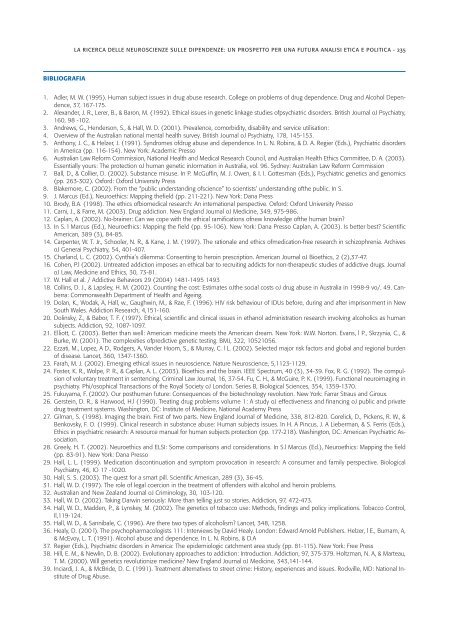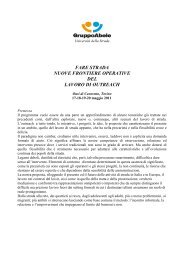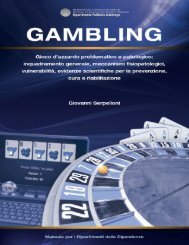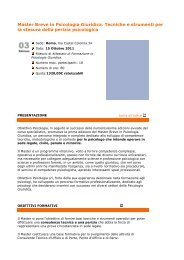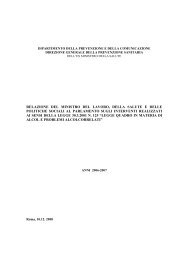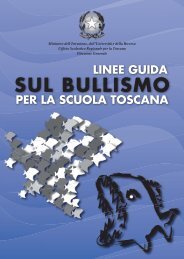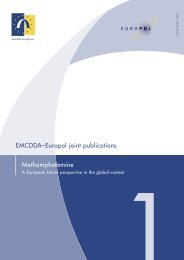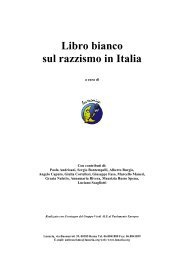Neuroscienze e dipendenze - Dipartimento per le politiche antidroga
Neuroscienze e dipendenze - Dipartimento per le politiche antidroga
Neuroscienze e dipendenze - Dipartimento per le politiche antidroga
You also want an ePaper? Increase the reach of your titles
YUMPU automatically turns print PDFs into web optimized ePapers that Google loves.
LA RICERCA DELLE NEUROSCIENZE SULLE DIPENDENZE: UN PROSPETTO PER UNA FUTURA ANALISI ETICA E POLITICA - 235<br />
BIBLIOGRAFIA<br />
1. Ad<strong>le</strong>r, M. W. (1995). Human subject issues in drug abuse research. Col<strong>le</strong>ge on prob<strong>le</strong>ms of drug dependence. Drug and Alcohol Dependence,<br />
37, 167-175.<br />
2. A<strong>le</strong>xander, J. R., Lerer, B., & Baron, M. (1992). Ethical issues in genetic linkage studies ofpsychiatric disorders. British Journal oJ Psychiatry,<br />
160, 98 -102.<br />
3. Andrews, G., Henderson, S., & Hall, W. D. (2001). Preva<strong>le</strong>nce, comorbidity, disability and service utilisation:<br />
4. Overview of the Australian national mental health survey. British Journal oJ Psychiatry, 178, 145-153.<br />
5. Anthony, J. C., & Helzer, J. (1991). Syndromes ofdrug abuse and dependence. In L. N. Robins, & D. A. Regier (Eds.), Psychiatric disorders<br />
in America (pp. 116-154). New York: Academic Presso<br />
6. Australian Law Reform Commission, National Health and MedicaI Research Council, and Australian Health Ethics Committee, D. A. (2003).<br />
Essentially yours: The protection oJ human genetic inJormation in Australia, vol. 96. Sydney: Australian Law Reform Commission<br />
7. Ball, D., & Collier, D. (2002). Substance misuse. In P. McGuffin, M. J. Owen, & I. I. Gottesman (Eds.), Psychiatric genetics and genomics<br />
(pp. 263-302). Oxford: Oxford University Press<br />
8. Blakemore, C. (2002). From the “public understanding ofscience” to scientists’ understanding ofthe public. In S.<br />
9. J. Marcus (Ed.), Neuroethics: Mapping thefield (pp. 211-221). New York: Dana Press<br />
10. Brody, B.A. (1998). The ethics ofbiomedical research: An intemational <strong>per</strong>spective. Oxford: Oxford University Presso<br />
11. Carni, J., & Farre, M. (2003). Drug addiction. New England Journal oJ Medicine, 349, 975-986.<br />
12. Caplan, A. (2002). No-brainer: Can we cope with the ethical ramifications ofnew know<strong>le</strong>dge ofthe human brain<br />
13. In S. l Marcus (Ed.), Neuroethics: Mapping the field (pp. 95-106). New York: Dana Presso Caplan, A. (2003). Is better best Scientific<br />
American, 389 (3), 84-85.<br />
14. Carpenter, W. T. Jr., Schoo<strong>le</strong>r, N. R., & Kane, J. M. (1997). The rationa<strong>le</strong> and ethics ofmedication-free research in schizophrenia. Archives<br />
oJ Generai Psychiatry, 54, 401-407.<br />
15. Charland, L. C. (2002). Cynthia’s di<strong>le</strong>mma: Consenting to heroin prescription. American Journal oJ Bioethics, 2 (2),37-47.<br />
16. Cohen, P.l (2002). Untreated addiction imposes an ethical bar to recruiting addicts for non-therapeutic studies of addictive drugs. Journal<br />
oJ Law, Medicine and Ethics, 30, 73-81.<br />
17. W. Hall et al. / Addictive Behaviors 29 (2004) 1481-1495 1493<br />
18. Collins, D. J., & Laps<strong>le</strong>y, H. M. (2002). Counting the cost: Estimates oJthe social costs oJ drug abuse in Australia in 1998-9 vo/. 49. Canberra:<br />
Commonwealth Department of Health and Ageing.<br />
19. Dolan, K., Wodak, A, Hall, w., Gaughwin, M., & Rae, F. (1996). HIV risk behaviour of IDUs before, during and after imprisonment in New<br />
South Wa<strong>le</strong>s. Addiction Research, 4,151-160.<br />
20. Dolinsky, Z., & Babor, T. F. (1997). Ethical, scientific and clinical issues in ethanol administration research involving alcoholics as human<br />
subjects. Addiction, 92, 1087-1097.<br />
21. Elliott, C. (2003). Better than well: American medicine meets the American dream. New York: W.W. Norton. Evans, l P., Skrzynia, C., &<br />
Burke, W. (2001). The comp<strong>le</strong>xities ofpredictive genetic testing. BMJ, 322, 10521056.<br />
22. Ezzati, M., Lopez, A D., Rodgers, A, Vander Hoom, S., & Murray, C. l L. (2002). Se<strong>le</strong>cted major risk factors and global and regional burden<br />
of disease. Lancet, 360, 1347-1360.<br />
23. Farah, M. J. (2002). Emerging ethical issues in neuroscience. Nature Neuroscience, 5,1123-1129.<br />
24. Foster, K. R., Wolpe, P. R., & Caplan, A. L. (2003). Bioethics and the brain. IEEE Spectrum, 40 (3), 34-39. Fox, R. G. (1992). The compulsion<br />
of voluntary treatment in sentencing. Criminal Law Journal, 16, 37-54. Fu, C. H., & McGuire, P. K. (1999). Functional neuroimaging in<br />
psychiatry. Phi/osophical Transactions of the Royal Society oJ London. Series B, Biological Sciences, 354, 1359-1370.<br />
25. Fukuyama, F. (2002). Our posthuman future: Consequences of the biotechnology revolution. New York: Farrar Straus and Giroux.<br />
26. Gerstein, D. R., & Harwood, H.l (1990). Treating drug prob<strong>le</strong>ms volume 1: A study oJ effectiveness and financing oJ public and private<br />
drug treatment systems. Washington, DC: Institute of Medicine, National Academy Press<br />
27. Gilman, S. (1998). Imaging the brain. First of two parts. New England Journal of Medicine, 338, 812-820. Gorelick, D., Pickens, R. W., &<br />
Benkovsky, F. O. (1999). Clinical research in substance abuse: Human subjects issues. In H. A Pincus, J. A Lieberman, & S. Ferris (Eds.),<br />
Ethics in psychiatric research: A resource manual for human subjects protection (pp. 177-218). Washington, DC: American Psychiatric Association.<br />
28. Greely, H. T. (2002). Neuroethics and ELSI: Some comparisons and considerations. In S.l Marcus (Ed.), Neuroethics: Mapping the field<br />
(pp. 83-91). New York: Dana Presso<br />
29. Hall, L. L. (1999). Medication discontinuation and symptom provocation in research: A consumer and family <strong>per</strong>spective. Biological<br />
Psychiatry, 46, IO 17 -1020.<br />
30. Hall, S. S. (2003). The quest for a smart pill. Scientific American, 289 (3), 36-45.<br />
31. Hall, W. D. (1997). The ro<strong>le</strong> of <strong>le</strong>gal coercion in the treatment of offenders with alcohol and heroin prob<strong>le</strong>ms.<br />
32. Australian and New Zealand Journal oJ Criminology, 30, 103-120.<br />
33. Hall, W. D. (2002). Taking Darwin seriously: More than telling just so stories. Addiction, 97, 472-473.<br />
34. Hall, W. D., Madden, P., & Lynskey, M. (2002). The genetics of tobacco use: Methods, findings and policy implications. Tobacco Control,<br />
Il,119-124.<br />
35. Hall, W. D., & Sanniba<strong>le</strong>, C. (1996). Are there two types of alcoholism Lancet, 348, 1258.<br />
36. Healy, D. (200 l). The psychopharmacologists 111: Interviews by David Healy. London: Edward Amold Publishers. Helzer, l E., Bumam, A,<br />
& McEvoy, L. T. (1991). Alcohol abuse and dependence. In L. N. Robins, & D.A<br />
37. Regier (Eds.), Psychiatric disorders in America: The epidemiologic catchment area study (pp. 81-115). New York: Free Press<br />
38. Hill, E. M., & Newlin, D. B. (2002). Evolutionary approaches to addiction: Introduction. Addiction, 97, 375-379. Holtzman, N. A, & Marteau,<br />
T. M. (2000). Will genetics revolutionize medicine New England Journal oJ Medicine, 343,141-144.<br />
39. Inciardi, J. A., & McBride, D. C. (1991). Treatment alternatives to street crime: History, ex<strong>per</strong>iences and issues. Rockvil<strong>le</strong>, MD: National Institute<br />
of Drug Abuse.


